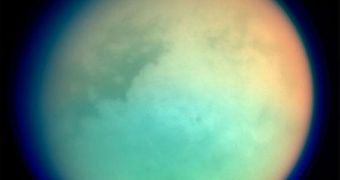The images sent by NASA's Cassini spacecraft indicate there's a high possibility that Saturn's largest moon, Titan, is subject to a dynamic volcanic activity. Instead of regular volcanoes on which we know a lot, these particular ones don't eject lava, but icy water, ammonia and methane, substances that may be responsible, if this is proven to be correct, for Titan's foggy atmosphere.
This comes as further evidence to the theory based on the probe's previous Titan flybys. The images collected by the spacecraft show a peculiar fog covering a flow-like formation on the moon's surface, which the experts believe to be a clue to the cryovolcanic activity. "Cryovolcanoes are some of the most intriguing features in the solar system," explained Rosaly Lopes, Cassini radar team investigation scientist at NASA's Jet Propulsion Laboratory in Pasadena, California, cited by PhysOrg. "To put them in perspective – if Mount Vesuvius had been a cryovolcano, its lava would have frozen the residents of Pompeii."
This idea was inferred from the variations in reflectance and brightness spotted in two different areas of Titan by the Visible and Infrared Mapping Spectrometer, from July 2004 to March 2006, and from the hints on ammonia presence in one of the locations when the region was believed to be active. The periodicity of the event suggests that ammonia, as well as methane, are brought to the surface from the interior of the moon, explaining the fact that Titan's atmosphere never runs out of methane.
Not all the scientists are convinced that the conclusions based on the photos are correct though, as some believe that the imaged features could also be the result of atmospheric processes instead of geophysical ones. "There remains the possibility that the effect is caused by a local fog, but if so, we would expect it to change in size over time due to wind activity, which is not what we see," claims JPL's Robert M. Nelson, a member of Cassini's Visual and Infrared Mapping Spectrometer team. More conclusions are expected to be drawn after Cassini's next flyby ten days from now.

 14 DAY TRIAL //
14 DAY TRIAL //